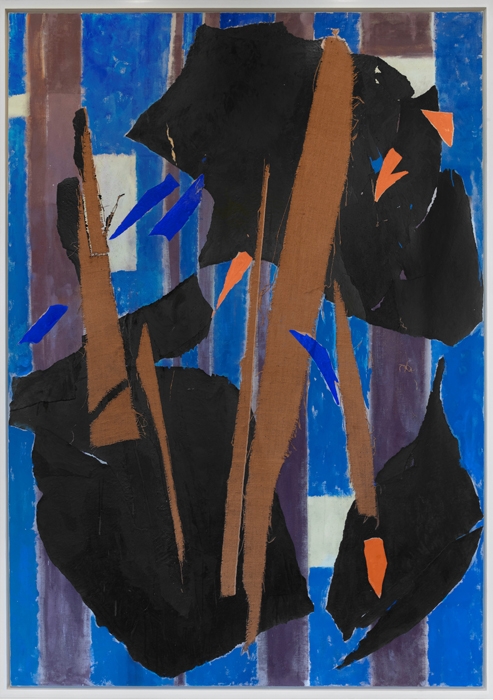Press coverage of Lee Krasner’s first European retrospective in half a century has almost uniformly invoked the name of the famous painter she married, typically as a way of summarising her longstanding and wrongheaded professional eclipse. If you somehow don’t know who that man was and you’re interested, look it up; and then be apprised that Krasner’s survey is simultaneously more consistent and adventurous than the last one he had in London, at Tate Modern, where this show should have been. Nor need we dwell lengthily on the background impetuses for Krasner’s overlooking and latter-day elevation, inarguable quality aside: think Cedar Tavern machismo, ‘difficult woman’ clichés and the current art-market’s need for new inventory and new (even if dead) heroes, and belated semi-rebalancing of gender inequality. The main thing to note, in terms of critical duty, is that Living Colour is the best big painting show in London for a fair while; I saw painters emerge open-mouthed.
The gallery’s split-level layout – a warren of upstairs nooks and expansive, modular downstairs spaces – mostly suits Krasner’s oeuvre, which divides here into the big, shape-shifting Abstract Expressionist and post-Ab Ex vistas of her 1950s-70s maturity, and a panoply of smaller early works and instructive ventures into medium-sized canvases and collages as she went along. Krasner’s earliest self-portraits, with their compositional echoes of Van Gogh, preserve her lifelong, penetrating, take-no-shit stare; in her unimpressed Self-Portrait (1928), painted when she was twenty, her face sits on the surface while her sombre eyes recede a foot deep, as if seeing what was coming. By her mid-thirties, after passing through an obligatory cubist phase that emerged, seemingly, from densely worked and steadily abstracting life drawing, she’d already grasped how to make a small canvas pass for big. Untitled (1946) is a polychrome square field of pinks, blues and yellows covered with short, scratchy marks rotating hyperactively in all directions; there’s a sense of luminous event that’s disproportionate to its tightly bounded space.
It’s around eight years later, though, that Krasner arrived at real greatness, first in works like Bird Talk (1955), tachisme crossed with Matisse’s cutouts: a tumble of torn-looking, overlapping shapes in a weird, dreamlike palette of tangerine, fuchsia and tan, their arrangement looking about to fly apart. A year later, circa Prophecy (1956) and its cousins, she was beating Willem de Kooning at his own game – if that game was fervid, wracked and taut abstractions of the body expressed through brutal architectonic composition and a deep affinity for soft shades of pink. At this point in the approximately chronological show, we’re still upstairs. Krasner has not gotten hold of big canvases. When we get there, specifically to Cinemascope works like The Eye is the First Circle (1960) – which suggests an outsize, abstracted Chinese ink drawing, a symphony of encircling brownish swirls and, in associative terms, several vortexes having a fight – the effect is almost comical. Here and in paintings like the same year’s levitating Polar Stampede, its tumult of purplish-brown strokes shot through with arctic fanfares of white, the musical analogy would be finding a clutch of lost, peak-period Beatles songs.
Except Krasner was never really lost, certainly not on her own terms. She just didn’t stay in a known place. The serene Kufic (1965), with its shapely palimpsest of mushroom-coloured loops and penumbra on a lighter ground, cleanly anticipates Brice Marden. By 1971’s Palingenesis, a flat and gnomic convocation of standalone green and pink shapes suggesting an uncrackable code, she’d arrived somewhere else entirely; by Olympic (1974), with its tidy graphic mix of arrowhead shapes and broken circles, somewhere else again. Two years later, eight years before her death, she was encouraged to revisit some old drawings: inventively and without nostalgia, she sliced them up into vividly shattered neo-cubist collages like Future Indicative (1976). What’s clear is that she was never held down by whatever ‘Abstract Expressionism’ might mean; she seemed in fact to float above it. The wild thing about Living Colour is that, for a belated full salute stretching to nearly 100 works, it still feels too small: particularly in the later phases, there is a sense of getting one or two sentences from a whole radiant chapter, and it cuts off in the mid-1970s. But this can be rectified later, maybe in subsequent stages of this touring show’s run; in terms of the painting pantheon, Krasner is now where she always belonged.
Lee Krasner: Living Colour at Barbican Art Gallery, London, 30 May – 1 September
From the October 2019 issue of ArtReview
